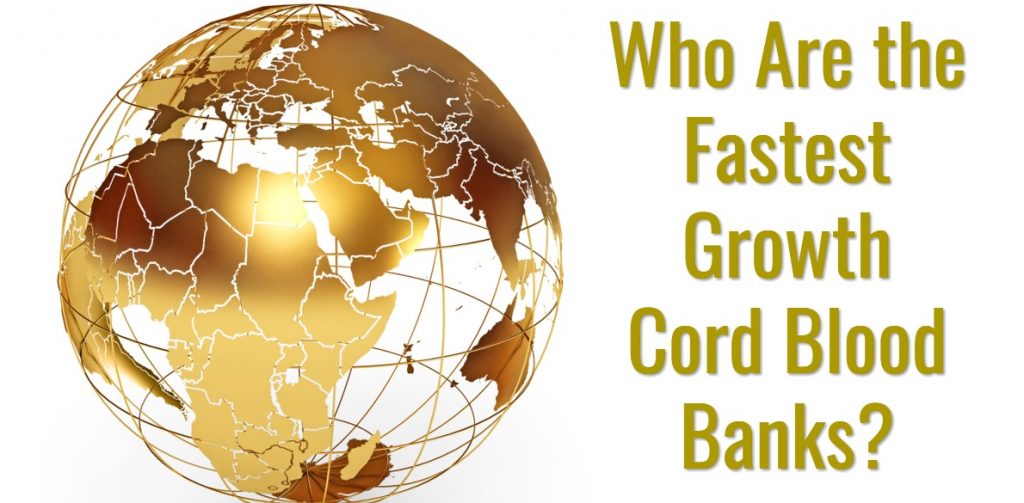While the global cord blood banking market has approximately 450 market participants, there are two fast growing cord blood banks that stand out among the competition. In this post, the fastest growth cord blood bank in the U.S and worldwide are featured, including their recent revenue metrics. The purpose of this analysis is to consider the strategies and actions being taken by these companies that have driven their rapid revenue growth over the past few years.
Fastest Growth Cord Blood Bank in the U.S.
Within the United States, Americord wins the award for fastest growth rate. In January 2014, Americord announced that it had achieved a growth rate of over 2,200% over the trailing three years of 2011 through 2013.1 This extraordinary success positions it as one of the top 200 fastest growing companies in the country.
As such, Americord is positioned to be a competitor for the Inc. 500 list of “fastest growing companies.” The Inc. 500 list uses three years of revenue growth over a benchmark fourth year as its metric for inclusion. Therefore, once Americord announces its full-year 2014 revenue metrics, it will be determined whether the company makes the prestigious Inc. 500 list.
Regardless, achieving a growth rate of 2,200% over a trailing three-year period is an exceptional growth rate. Not surprisingly, Americord has openly stated that it intends to become the “leading provider of cord blood and cord tissue services” within the United States.2
Americord has several characteristics that explain its growth rate advantage over other major competitors, such as Cord Blood Registry. These include substantially lower costs for collection and 20 years of storage (standard contract term), no cancellation fees, and a higher quality guarantee.
Currently, the top cord blood banks in America offer “Quality Guarantee” packages that range from $25,000 to $90,000, with Americord topping that list at $90,000. Quality guarantees ensure that if a cord blood unit is needed for medical purposes, then engraftment of it will be a success or the amount of their guarantee will be paid out toward procurement of an alternative source of stem cells or medical treatment. Americord raised its guarantee from $80,000 to $90,000 in mid-2014 to further separate itself from the competition and increase its trustworthiness in the eyes of its clients.
However, Americord does have a growth advantage over some of the larger cord blood banks, like Cord Blood Registry (600,000 samples stored) and ViaCord (350,000 samples stored), because it has stored a comparatively smaller number of cord blood units (35,000), which makes year-over-year growth more accessible.
Fastest Growth Cord Blood Bank Worldwide
Internationally, China Cord Blood Corporation (CCBC) wins the award for fastest growth rate. CCBC became the first cord blood banking operation in China when it began operations in 2003. It was also the first cord blood bank in China to receive ISO900 certification and is now also AABB accredited. In addition, it is now the largest cord blood banking operator in China in terms of geographical coverage and is the only one operating with multiple licenses.
It holds the exclusive license for 3 of the regions (Beijing, Guangdong, and Zhejiang) and has partial ownership in a 4th region through its 24% share in Shandong Cord Blood Bank. It entered Beijing in 2003, Guangdong in 2007, and Zhejiang in 2011. Within the regions that the company operates, there are approximately 2 million new births every year, allowing for a large potential market.3 All of the other licensees in China hold only one license. China Cord Blood Corp is also the fastest growing cord blood bank worldwide, according to its CEO, Mr. Chen.4
The company has experienced very robust and consistent revenue growth, with both CAGR and EBITA averaging 24% for the period of 2009 to 2014.5 (Note: CAGR = Compounded Annual Growth Rate; EBITDA = Earnings Before Depreciation, Interest, Taxes, and Amortization)
As required within the country, China Cord Blood Corporation functions as a hybrid cord blood bank, with both public and private operating divisions. Despite being of one of the largest public cord blood banks in China, the company receives no funding from the Chinese government to operate its public banking infrastructure. However, the company does have a strategic collaboration with Cordlife Group Limited (“CordLife”) to share its donated samples database for purposes of increasing the probability that those seeking a hematopoietic stem cell therapy will find a match.
China Cord Blood Corporation’s public division has also been very successful, with a CAGR of 26% for accumulated donated units and a 26.5% CAGR for donated units used in medical treatments from 2009 to 2014.6
1 Prnewswire.com, (2014). With record cord blood collections, Americord aims for Inc. 500. [online] Available at: http://www.prnewswire.com/news-releases/with-record-cord-blood-collections-americord-aims-for-inc-500-240158921.html [Accessed 4 Nov. 2014].
2 Umbilical Cord Blood Banking and Cord Tissue Banking, (2014). Cord Blood Banking Cost | Americord. [online] Available at: http://americordblood.com/cord-blood-costs-and-services [Accessed 3 Nov. 2014].
3 Chen, A. (2014). Presentation: The Commercialization of Umbilical Cord Blood Banking in China and its Operational Challenges. World Cord Blood Congress, September 17, 2014.
4 Ibid.
5 Ibid.
6 Ibid.
